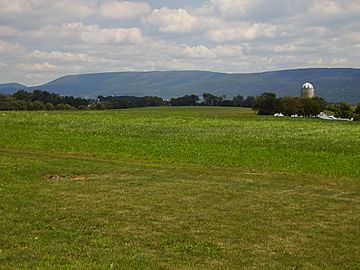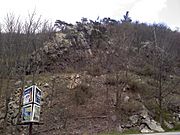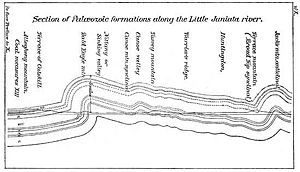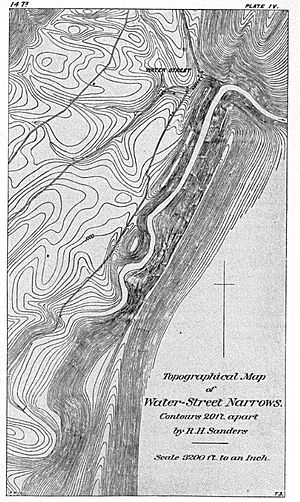Tussey Mountain facts for kids
Quick facts for kids Tussey Mountain |
|
|---|---|

Tussey Mountain Ridge
|
|
| Highest point | |
| Elevation | 2,740 ft (840 m) (at Martin Hill) |
| Geography | |
| Location | Pennsylvania, U.S. |
| Parent range | Appalachian Mountains |
| Topo map | USGS Hopewell (PA) Quadrangle |
Tussey Mountain is a long, narrow mountain ridge in central Pennsylvania, United States. It's like a giant, long bump on the Earth's surface that stretches for about 130 kilometers (80 miles)! This makes it one of the longest named ridges in the Ridge-and-Valley Appalachians area.
The mountain starts near the Mason–Dixon line in Maryland and goes north all the way to the Seven Mountains in central Pennsylvania, close to Tusseyville. Tussey Mountain acts like a natural wall, separating different valleys. For example, it divides Morrisons Cove from the Woodcock Valley, and Friends Cove from the Black Valley. The ridge also forms parts of the borders for several counties, including Centre, Blair, Bedford, and Huntingdon counties.
Contents
How Do Rivers Cross Tussey Mountain?
Many rivers and roads have found ways to cut through Tussey Mountain. These cuts are called "gaps." For instance, the Flintstone Creek flows around the southern end of the mountain in Maryland. Further north, you'll find deep, narrow valleys like Sweet Root and Rainsburg Gaps.
Near Everett, the Pennsylvania Turnpike and U.S. Route 30 pass through a famous water gap called The Narrows. Here, the Raystown Branch Juniata River has carved its way through the mountain. Other important gaps include Loysburg Gap where the Yellow Creek flows, and a wind gap near Pulpit Hill. A wind gap is a pass where a river used to flow but doesn't anymore.
The Frankstown Branch Juniata River and U.S. Route 22 cross the ridge at Water Street. Even the Little Juniata River has its own water gap near Spruce Creek. Near the northern end, close to the Tussey Mountain Ski Area in Boalsburg, Galbraith Run passes through Galbraith Gap.
Why is Tussey Mountain Important for Nature?
Tussey Mountain is a very special place for nature, especially for birds. It's a popular spot for soaring birds and glider pilots who use the air currents rising along its slopes. This mountain is part of a long chain of ridges that stretches all the way south to Tennessee.
Because of its importance for birds, Tussey Mountain has been named a Pennsylvania Important Bird Area (IBA). It's a fantastic place to watch golden eagles as they migrate (travel) in the spring. More than half of the forest on Tussey Mountain is protected public land, making it a long, healthy home for many animals.
Pennsylvania's longest walking path, the Mid State Trail, follows Tussey Mountain for almost its entire length. This means you can hike along the mountain for a very long time!
Different Names for Tussey Mountain
Sometimes, people call Tussey Mountain by different names depending on where they are. In Blair County, it's sometimes called Huntingdon Mountain because you cross it to get to Huntingdon. But in parts of Huntingdon County, it's called Williamsburg Mountain because you cross it to get to Williamsburg.
Pennsylvania State Game Lands Number 118 is a protected area for wildlife located along Tussey Mountain in Blair and Huntingdon Counties.
What is the Geology of Tussey Mountain?
Tussey Mountain is part of the Ridge-and-Valley Appalachians region of the Appalachian Mountains. Imagine the Earth's layers of rock like a stack of pancakes. Millions of years ago, during a time called the Appalachian orogeny (a period when mountains were formed), these rock layers were pushed and folded upwards. This created a giant arch, like a huge upside-down U, called the Nittany Arch.
This ancient mountain was once as tall as the Himalayas! Over a very long time, wind and water caused erosion, wearing away the top layers of the mountain. This exposed older rock layers that were once deep inside.
What Rocks Make Up Tussey Mountain?
Tussey Mountain is made of very strong rocks that resist erosion. The main rocks are Bald Eagle Formation Sandstone and Juniata Formation Shale, which are older, and Tuscarora Formation Quartzite, which is a bit younger. The Tuscarora Quartzite is especially tough, even harder than the Bald Eagle Sandstone. The Juniata Shale is softer and is found between these two harder layers.

Because the Tuscarora Quartzite is so strong, it protected the eastern side of the mountain from being worn away. This is why Tussey Mountain often has two crests (or tops) – a higher eastern one and a slightly lower western one, with a dip in between. The softer rock layers on either side of these hard rocks eroded away, leaving the strong Tussey Mountain ridge standing tall.



